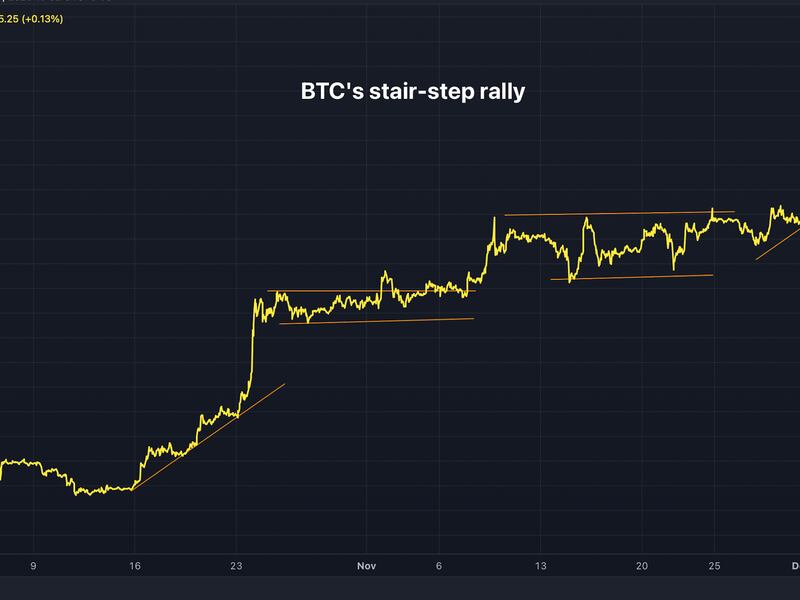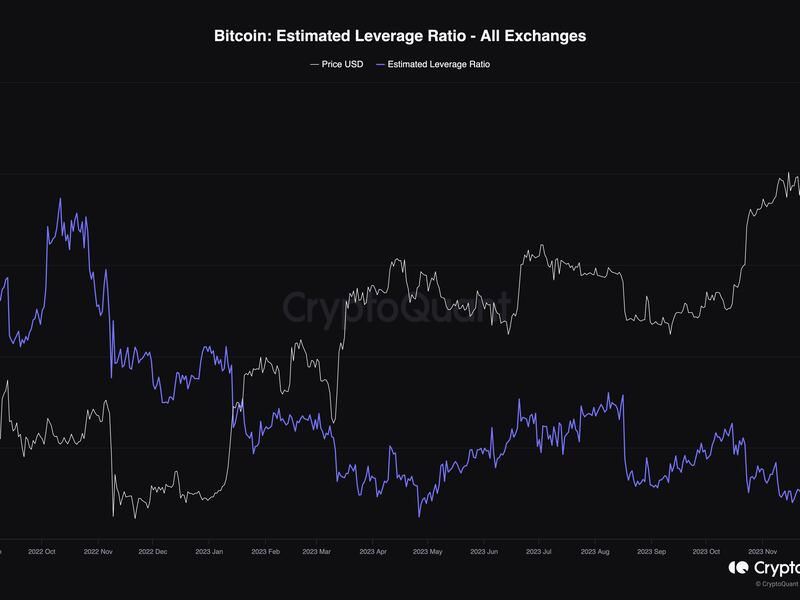Here's Why Bitcoin's Famed Bull-Market Pullbacks Have Been Elusive During the Recent Price Surge

- BTC's bull run is characterized by stair-step price action, comprising a series of price gains and horizontal consolidations.
- A spot-led rally and low leverage ensure the famed double-digit bull-market pullbacks remain elusive.
At least half of bitcoin's [BTC] 160% surge this year has materialized in just the past eight weeks.
The trend looks more impressive given its stepwise structure of a series of price rallies and horizontal consolidation runs. That starkly contrasts with past rallies, including the rally in late 2020-early 2021, when pullbacks of 20% or more were common.
Those pullbacks have remained elusive this time around, possibly because spot-market buyers have been in the driver's seat.
"The bull market has been a clearly spot-driven bull market, with all major derivatives data relatively flat, futures premiums holding around 10%, and options IVs [implied volatility] not showing significant gains," options data tracking website Greeks.Live said on X. "We have to put this rally and the news of the impending passage of the ETF in perspective; this spot bull market is very healthy, the downside is limited, and the bull market is here to stay."

A spot market is where an asset is traded for immediate delivery. Derivatives involve futures and options, whose value is derived from the underlying asset, and these instruments are settled in the future.
According to CCData, spot and derivatives trading volume on centralized exchanges rose to an eight-month high of $3.61 trillion in November, with the share of derivatives declining for the third straight month to 73%. Data tracked by analytics firm CryptoQuant show bitcoin's spot-to-derivatives trading volume ratio jumped to nearly 0.10 from 0.05 last month, indicating increased activity in the spot market.
While derivatives still account for the majority of market volume, the degree of leverage in the system remains low, supporting the stair-step price ascent.
Derivatives are usually leveraged instruments, allowing traders to take bullish (long) or bearish (short) positions worth more than the amount they have deposited as a margin at the exchange. Leverage is a double-edged sword, magnifying both profits and losses. It also exposes traders to liquidations, or forced unwinding, due to margin shortfalls. Furthermore, mass liquidations often lead to exaggerated bullish or bearish moves, so the greater the use of leverage, the higher the probability of liquidations injecting volatility into the market.

The estimated leverage ratio, calculated by dividing the dollar value locked in active open perpetual futures contracts by the total value of coins held by derivatives exchanges, remains near April's low of 0.20, having peaked above 0.40 last year, according to data source CryptoQuant.
Most leading exchanges, including Binance, now offer 20x or lower leverage in derivatives trading, allowing speculators to establish long positions controlling 20 times the value of their collateral. That's significantly below the 100x available during previous bull runs. Such high use of leverage meant less staying power when things turned bad and vulnerability to liquidations-induced downside volatility, as observed during the 2020-21 bull run.
Besides, activity is now more concentrated in standard futures on the regulated Chicago Mercantile Exchange (CME), where institutions and sophisticated traders rarely employ extreme leverage. Derivatives trading on the CME rose 18.4% to $67.9 billion in November, the highest in two years, according to CCData. CME also overtook Binance as the largest derivatives exchange, with open interest in BTC rising 21% to $4.11 billion.
Lastly, the use of coins as margin for trading peaked in 2021-22. Now, cash or stablecoin-margined contracts account for most of the open interest in BTC futures. Cash-margined contracts offer a linear payoff, while coin-margined contracts, where the collateral is as volatile as the trading position, create a greater liquidation risk.








